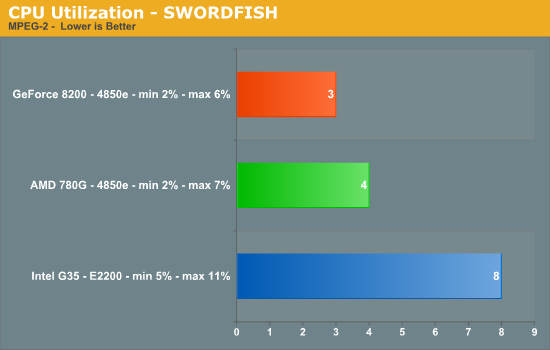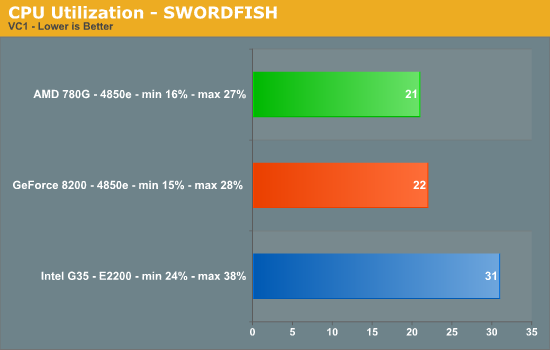AMD 780G: Preview of the Best Current IGP Solution
by Gary Key on March 10, 2008 12:00 PM EST- Posted in
- CPUs
Testing Notes
Our image quality tests today consists of still screenshots from several movies in our collection, actually the primary criteria were movies that offered decent bitrates and were screen capture friendly under DRM infested Vista. While we tried to capture the exact moment within a frame to compare the 780G to the G35/GF8200, this was not always possible. However, we did our best to capture the screenshots on the same frame but at times; the capture process grabbed the beginning of the frame or the trailing end.
In the end, we feel like the process is close enough to give you an indication to any differences between the images. Obviously, we cannot show the reference image but will comment as to which screen shot best represented the reference image on our home theater system. We find measuring video output quality in this manner a subjective process to some degree, as at times we liked an image that did not match the reference screenshot better than the one that did. Considering that fact, we decided to bring eight people in to give us their opinions during playback sequences and then still-shot reviews.
We utilized PowerDVD 7.3 (build 3610 utilized, 3730 in testing) for playback with all settings on auto, except we enabled hardware acceleration within the application. We measured CPU utilization and bitrate results with the Vista Task Manager and PowerDVD Info applications respectively. We took readings every five minutes and averaged the results at the end of the movie. Movies were played back in full screen mode at their native resolutions with the desktop set to 1920x1200. We will show discrete card results in our next article. However, the HD 3450 provided results that were just a few percent better than the HD 3200 with the released 8.3 driver set.
Audio settings selected were Dolby Digital 5.1, DTS 5.1, or two-channel LPCM where applicable. Unlike the 780G, the G35 and GeForce 8200 fully supports multi-channel LPCM output and we will comment on results with either LPCM 5.1 or Dolby TrueHD decoded streams (via PowerDVD) where applicable.
We calibrated both systems on our Gateway XHD3000 monitor to ensure the color palettes were set equally. Fine tuning the control panel settings for each of the test setups can and will improve the picture quality but we will leave that up to the user to decide their preferences. We played back the movie sequences on the Gateway monitor for initial viewing and judging. We proceeded to output the same movie sequences on our calibrated Samsung 61" (HL-T6187S) DLP set utilizing the same control panel and PowerDVD settings to view the images in an HT setting.
We then utilized our test setups to pass through the image and audio via HDMI to our Pioneer Elite VSX-94THX A/V receiver. Using the receiver as a "repeater", we output the native signal (our preferred method to PWDVD) to our HT setup (7.1 audio/Samsung 61” DLP) for our test subjects. We will list their preferences in our comments section. We will also warn you in advance that the original images are generally 2MB to 3MB in size if you decide to download them.
MPEG 2 Video Quality - SWORDFISH
We are utilizing the movie SWORDFISH from Warner Brothers, what else can we say, we still like seeing Halle Berry in the lounge chair. This movie offers bitrate levels that averaged 5.4 Mb/s to 8.1 Mb/s on average. In our particular test scene, John Travolta is drinking a cup of coffee in a close up shot that highlights skin tones along with reflections off the cup and background objects.
 780G – Click to Enlarge |
 G35 – Click to Enlarge
|
 GeForce 8200 – Click to Enlarge |
The differences in the images are minor but the G35 appears to have slightly deeper colors along with a slight edge in sharpness while the GeForce 8200 offers additional contrast and a better background image, but being darker overall. However, the 780G image was faithful to the reference image during playback tests. Our test audience placed 4 votes for the 780G, 2 for the G35, and 2 for the GeForce 8200.

CPU utilization during playback favors the 780G and GeForce 8200 on average by 4%. This was surprising to us as the G35 does not offer full hardware decode capabilities for MPEG-2 playback. However, we never had a problem with playback in this title and others such as Cars and Spiderman 3.
VC1 Video Quality - SWORDFISH
SWORDFISH is not a very demanding movie in 1080P playback but the image screenshots should give a good indication to the improvement when going from MPEG-2 to VC1. This movie offers bitrate levels that averaged 15.7 Mb/s to 25.2 Mb/s on average. Once again, we utilize the coffee shop test scene.
 780G – Click to Enlarge |
 G35 – Click to Enlarge |
 GeForce 8200 – Click to Enlarge |
The differences in the images are once again minor but this time the 780G appears to have better skin tones while sharpness and overall color palette seems to favor the G35. We thought the GeForce 8200 image was slightly on the flat side when comparing facial details but had the best background details. The 780G image was more faithful to the reference image during playback tests. The 780G garnered 3 votes, 3 to the G35, and 2 for the GeForce 8200.

CPU utilization during playback favors the GeForce 8200 and 780G by a several percent even though the G35 offers hardware accelerated decoding of the VC1 format. There were not any judder or stuttering problems on any of the platforms during playback.










49 Comments
View All Comments
Gary Key - Tuesday, March 11, 2008 - link
The 790GX features the HD 3300, which is a slight upgrade to the HD 3200 on the 780G. We are told the IGP performance differences will be slightly improved, but until we have the chipset and drivers, it will be difficult to determine if those improvement are meaningful or not. At this time, AMD is quiet about actual specs and capabilities of the 790GX. If you are a very casual gamer, Sims2/UT2004/CoH type of games then Hybrid CrossFire is a decent solution up to 1280x1024 resolution. If you want to run upcoming games and Crysis at an acceptable rate, then discreet graphics is the way to go.At this time, if you want an uATX form factor, the 780G is the best AMD chipset for discrete graphics performance. I have not found any real difference in performance between it and a 770X board with a HD 3870 installed. You need to go up to the 790FX for the best performing chipset with an AM2+ CPU right now. I will update this if we get a performance oriented BIOS for the GeForce 8200 board which may or may not changes its performance capabilities.
Genx87 - Monday, March 10, 2008 - link
Maybe it is late.What is the expected cost and release date of this motherboard?
Gary Key - Tuesday, March 11, 2008 - link
The reader who responded basically answered the supply and price question. :) NewEgg was running a special on the ECS board this week for %59.99 with a rebate. Our information is that all of the launch partners for this board should have supply in the channel by the end of March or early April at worst. The feature sets will determine the prices but AMD was shooting for an average street price of $75 on the 780G. The 780V will be a white box or OEM only SKU for now.The J&W board will not be available in the US or Canada at this time. It is the only board we have in-house that offers the SidePort memory option and with the latest 8.3 drivers, it makes a 5%~10% difference in a few games. AMD is telling us the final 8.4 drivers should allow this option to assist in lowering CPU utilization by a few percent also.
goinginstyle - Tuesday, March 11, 2008 - link
The Gigabyte, ASUS, and ECS boards are available (if in stock) in the Americas at prices ranging from $69 to $99. In Europe and APAC, the J&W boards (along with the others) are available currently. The J&W will be our choice for the more performance oriented user. We expect to see boards from Biostar, abit, MSI, and Foxconn shortly at prices under $100, average MSRP for this chipset should be around $80 once supply is plentiful.goinginstyle - Tuesday, March 11, 2008 - link
Hit the enter button too soon but that information is from another website that will not be mentioned just in case it is a violation of the rules here. I bought the Gigabyte board from NEWEGG last week for $95 and found out today that the 780G chipset shows ENG0752 on it. Any comments on your boards having ENG chipsets?eches - Monday, March 10, 2008 - link
BUT sadly almost useless to me since all my HTPC builds run Linux. It would be VERY interesting to see a comparison in terms of Linux to Windows playback quality/performance since the drivers are bound to make a huge difference here.Also some interesting comments - my Linux HTPC runs an XP2600 (OC to 2.1 Ghz) and only just manages to handle 720p MKV playback. Can a Sempron at 1.8Ghz really manage 720p under Windows? Might be time for an upgrade *grin*
phusg - Tuesday, March 11, 2008 - link
Your hardware should be plenty to playback 720p video. If only something as efficient as CoreCodec's CoreAVC was available for linux. What do you presently use to playback? Is the playback totally smooth?It's also a shame the hardware acceleration of HD video on the newer AGP cards isn't available on the linux side, that would be another cheap way to stretch your hardware :)
eches - Wednesday, March 12, 2008 - link
Smooth at 2.13Ghz, but with some sound sync issues - this is with Xine and all de-interlacing/post-processing disabled (and minimal background processing). And indeed I am awaiting the CoreAVC player for Linux (yes, I could patch MPlayer but I'm also trying to keep the HTPC low maintenance) since this is a quick and cheap way of making the most of this old hardware.And cheers Gary! I look forward to the Linux article with GREAT interest - will you also be taking a look at NVidia cards and doing a quality comparison?
Gary Key - Tuesday, March 11, 2008 - link
We just shipped a 780G board to one of our upcoming Linux editors to test. We should have some initial results in the next couple of weeks. I have not had a pleasurable experience with the Sempron 3400+ doing encoding/decoding work on this board under Vista. It is something I am still working on for a future HTPC article, one that we will recommend/show just how low you can go with the new IGP boards and still have a "well performing" system. Does a Sempron 3400+ and a HD 3450 card for a total outlay of $85 offer better performance on this board than a 4850e CPU only for the same price. This is something we are trying to answer with Intel, NVIDIA, and AMD hardware.eches - Wednesday, March 12, 2008 - link
Sorry I had tacked on a "cheers" at the end of the reply further down - GREAT stuff!"How Low Can You Go?" eh? Sounds very interesting but complex if done properly (i.e. Tests on Vista, XP and Linux; and a need to cover quite a few players in order to do quality/performance comparisons). A look at power consumption would also add an interesting slant - *possibly* putting XP/Vista in a different light when once considers TCO and Linuxs often poor power management.
Personally I was surprised to get a XP2600 to play 720p content and could probably get it smooth without an OC if I used CoreAVC and a dedicated sound card. Given we're talking 6 year old 'junk' hardware here, a free OS etc. thats pretty low!